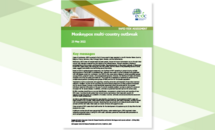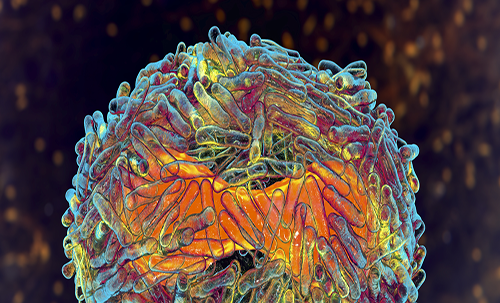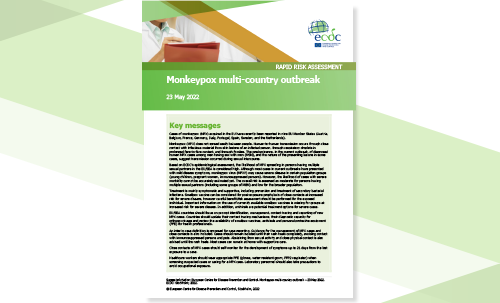ECDC presents monkeypox response options, as nine EU/EEA countries report cases
News
23 May 2022
In a Rapid Risk Assessment published today, the European Centre for Disease Prevention and Control (ECDC) recommends EU/EEA countries focus on prompt identification, management, contact tracing and reporting of new monkeypox cases. Countries should also update their contact tracing mechanisms, the diagnostic capacity for orthopoxviruses, and review the availability of smallpox vaccines, antivirals and personal protective equipment for health professionals.
As of 23 May 2022, 67 confirmed cases had been reported in nine EU/EEA Member States (Austria, Belgium, France, Germany, Italy, Netherlands, Portugal, Spain, Sweden) and at least an additional 42 suspected cases were under investigation. The currently diagnosed human monkeypox cases are primarily among men who have sex with men, which suggests that transmission may take place during intimate relations. Transmission may occur through close contact of mucosa or non-intact skin with infectious material from the lesions, or through large respiratory droplets during prolonged face-to-face contact.
“Most of the current cases have presented with mild disease symptoms, and for the broader population, the likelihood of spread is very low,” said Andrea Ammon, ECDC Director. “However, the likelihood of further spread of the virus through close contact, for example during sexual activities among persons with multiple sexual partners, is considered to be high.”
Stella Kyriakides, European Commissioner for Health and Food Safety, added “I am concerned about the increased number of reported monkeypox cases in the EU and globally. We are closely monitoring the situation, and whilst currently the likelihood of spread in the broader population is low, the situation is evolving. We all need to remain vigilant, ensure that contact tracing and adequate diagnostics capacity is in place, and ensure that we have the necessary vaccines, antivirals and personal protective equipment for health professionals available. We have been in close contact with Member States since the first reports of cases of the monkeypox virus in the EU and stand ready to actively support and coordinate the EU response with all assets at the EU’s disposal. The EU Health Security Committee will discuss monkeypox tomorrow, and our Health Emergency Response and Preparedness Authority (HERA), ECDC and EMA are working closely together to ensure that information on the epidemiological situation and the availability of vaccines and treatments is ensured.”
The monkeypox virus can cause severe disease in certain population groups, such as young children, pregnant women and immunosuppressed persons. Further investigations are needed to accurately estimate the level of morbidity and mortality in this outbreak.
If human-to-animal transmission occurs, and the virus spreads in an animal population, there is a risk that the disease could become endemic in Europe. As such, there needs to be a close intersectoral collaboration between human and veterinary public health authorities to manage exposed pets and prevent the disease from being transmitted to wildlife.
Infected persons should remain isolated until scabs fall off and should especially avoid close contact with immunosuppressed persons and pets. Abstaining from sexual activity and close physical contact is also advised until the rash heals. Most cases can remain at home with supportive care.
Close contacts of monkeypox cases should self-monitor for the development of symptoms for 21 days after the last exposure. ECDC will continue to monitor developments closely and will update the risk assessment as new data and information become available.
...
---------------------------------------------------------------------------
Risk assessment: Monkeypox multi-country outbreak
Risk assessment
23 May 2022
Cite:
Citation Link
Cases of monkeypox (MPX) acquired in the EU have recently been reported in nine EU Member States (Austria, Belgium, France, Germany, Italy, Portugal, Spain, Sweden, and the Netherlands).
Executive summary
Key messages
Monkeypox (MPX) does not spread easily between people. Human-to-human transmission occurs through close contact with infectious material from skin lesions of an infected person, through respiratory droplets in prolonged face-to-face contact, and through fomites. The predominance, in the current outbreak, of diagnosed human MPX cases among men having sex with men (MSM), and the nature of the presenting lesions in some cases, suggest transmission occurred during sexual intercourse.
Based on ECDC’s epidemiological assessment, the likelihood of MPX spreading in persons having multiple sexual partners in the EU/EEA is considered high. Although most cases in current outbreaks have presented with mild disease symptoms, monkeypox virus (MPXV) may cause severe disease in certain population groups (young children, pregnant women, immunosuppressed persons). However, the likelihood of cases with severe morbidity cannot be accurately estimated yet. The overall risk is assessed as moderate for persons having multiple sexual partners (including some groups of MSM) and low for the broader population.
Treatment is mainly symptomatic and supportive, including prevention and treatment of secondary bacterial infections. Smallpox vaccine can be considered for post-exposure prophylaxis of close contacts at increased risk for severe disease, however careful benefit/risk assessment should be performed for the exposed individual. Important information on the use of currently available smallpox vaccines is missing for groups at increased risk for severe disease. In addition, antivirals are potential treatment options for severe cases.
EU/EEA countries should focus on prompt identification, management, contact tracing and reporting of new MPX cases. Countries should update their contact tracing mechanisms, their diagnostic capacity for orthopoxviruses and review the availability of smallpox vaccines, antivirals and personal protective equipment (PPE) for health professionals.
An interim case definition is proposed for case reporting. Guidance for the management of MPX cases and close contacts is also included. Cases should remain isolated until their rash heals completely, avoiding contact with immunosuppressed persons and pets. Abstaining from sexual activity and close physical contact is also advised until the rash heals. Most cases can remain at home with supportive care.
Close contacts of MPX cases should self-monitor for the development of symptoms up to 21 days from the last exposure to a case.
Healthcare workers should wear appropriate PPE (gloves, water-resistant gown, FFP2 respirator) when screening suspected cases or caring for a MPX case. Laboratory personnel should also take precautions to avoid occupational exposure.
Close contacts of a MPX case should be deferred from blood, organ or bone marrow donations for a minimum of 21 days from the last day of exposure.
Proactive risk communication and multiple community engagement activities should be carried out to increase awareness, provide updates and guidance to those at increased risk and the wider public. Risk communication messages should stress that MPXV is spread through close contact between people, especially in the same household, potentially including the sexual route. A balance should be kept between informing those most at risk but also communicating that the virus does not spread easily between people the risk to the broader population is low.
There is a potential risk of human-to-animal transmission in Europe, therefore close intersectoral collaboration between human and veterinary public health authorities working from a ‘One Health’ perspective is needed to manage exposed pets and prevent the disease from being transmitted in wildlife. EFSA is not aware to date of any reports on infections in animals (pets or wild animals) in the EU.
Several unknowns still exist regarding this outbreak and ECDC will continue to monitor developments closely and update the risk assessment as new data and information become available.
Download

Risk assessment: Monkeypox multi-country outbreak - EN - [PDF-598.63 KB]
News
23 May 2022
In a Rapid Risk Assessment published today, the European Centre for Disease Prevention and Control (ECDC) recommends EU/EEA countries focus on prompt identification, management, contact tracing and reporting of new monkeypox cases. Countries should also update their contact tracing mechanisms, the diagnostic capacity for orthopoxviruses, and review the availability of smallpox vaccines, antivirals and personal protective equipment for health professionals.
As of 23 May 2022, 67 confirmed cases had been reported in nine EU/EEA Member States (Austria, Belgium, France, Germany, Italy, Netherlands, Portugal, Spain, Sweden) and at least an additional 42 suspected cases were under investigation. The currently diagnosed human monkeypox cases are primarily among men who have sex with men, which suggests that transmission may take place during intimate relations. Transmission may occur through close contact of mucosa or non-intact skin with infectious material from the lesions, or through large respiratory droplets during prolonged face-to-face contact.
“Most of the current cases have presented with mild disease symptoms, and for the broader population, the likelihood of spread is very low,” said Andrea Ammon, ECDC Director. “However, the likelihood of further spread of the virus through close contact, for example during sexual activities among persons with multiple sexual partners, is considered to be high.”
Stella Kyriakides, European Commissioner for Health and Food Safety, added “I am concerned about the increased number of reported monkeypox cases in the EU and globally. We are closely monitoring the situation, and whilst currently the likelihood of spread in the broader population is low, the situation is evolving. We all need to remain vigilant, ensure that contact tracing and adequate diagnostics capacity is in place, and ensure that we have the necessary vaccines, antivirals and personal protective equipment for health professionals available. We have been in close contact with Member States since the first reports of cases of the monkeypox virus in the EU and stand ready to actively support and coordinate the EU response with all assets at the EU’s disposal. The EU Health Security Committee will discuss monkeypox tomorrow, and our Health Emergency Response and Preparedness Authority (HERA), ECDC and EMA are working closely together to ensure that information on the epidemiological situation and the availability of vaccines and treatments is ensured.”
The monkeypox virus can cause severe disease in certain population groups, such as young children, pregnant women and immunosuppressed persons. Further investigations are needed to accurately estimate the level of morbidity and mortality in this outbreak.
If human-to-animal transmission occurs, and the virus spreads in an animal population, there is a risk that the disease could become endemic in Europe. As such, there needs to be a close intersectoral collaboration between human and veterinary public health authorities to manage exposed pets and prevent the disease from being transmitted to wildlife.
Infected persons should remain isolated until scabs fall off and should especially avoid close contact with immunosuppressed persons and pets. Abstaining from sexual activity and close physical contact is also advised until the rash heals. Most cases can remain at home with supportive care.
Close contacts of monkeypox cases should self-monitor for the development of symptoms for 21 days after the last exposure. ECDC will continue to monitor developments closely and will update the risk assessment as new data and information become available.
...
---------------------------------------------------------------------------
Risk assessment: Monkeypox multi-country outbreak
Risk assessment
23 May 2022
Cite:
Citation Link
Cases of monkeypox (MPX) acquired in the EU have recently been reported in nine EU Member States (Austria, Belgium, France, Germany, Italy, Portugal, Spain, Sweden, and the Netherlands).
Executive summary
Key messages
Monkeypox (MPX) does not spread easily between people. Human-to-human transmission occurs through close contact with infectious material from skin lesions of an infected person, through respiratory droplets in prolonged face-to-face contact, and through fomites. The predominance, in the current outbreak, of diagnosed human MPX cases among men having sex with men (MSM), and the nature of the presenting lesions in some cases, suggest transmission occurred during sexual intercourse.
Based on ECDC’s epidemiological assessment, the likelihood of MPX spreading in persons having multiple sexual partners in the EU/EEA is considered high. Although most cases in current outbreaks have presented with mild disease symptoms, monkeypox virus (MPXV) may cause severe disease in certain population groups (young children, pregnant women, immunosuppressed persons). However, the likelihood of cases with severe morbidity cannot be accurately estimated yet. The overall risk is assessed as moderate for persons having multiple sexual partners (including some groups of MSM) and low for the broader population.
Treatment is mainly symptomatic and supportive, including prevention and treatment of secondary bacterial infections. Smallpox vaccine can be considered for post-exposure prophylaxis of close contacts at increased risk for severe disease, however careful benefit/risk assessment should be performed for the exposed individual. Important information on the use of currently available smallpox vaccines is missing for groups at increased risk for severe disease. In addition, antivirals are potential treatment options for severe cases.
EU/EEA countries should focus on prompt identification, management, contact tracing and reporting of new MPX cases. Countries should update their contact tracing mechanisms, their diagnostic capacity for orthopoxviruses and review the availability of smallpox vaccines, antivirals and personal protective equipment (PPE) for health professionals.
An interim case definition is proposed for case reporting. Guidance for the management of MPX cases and close contacts is also included. Cases should remain isolated until their rash heals completely, avoiding contact with immunosuppressed persons and pets. Abstaining from sexual activity and close physical contact is also advised until the rash heals. Most cases can remain at home with supportive care.
Close contacts of MPX cases should self-monitor for the development of symptoms up to 21 days from the last exposure to a case.
Healthcare workers should wear appropriate PPE (gloves, water-resistant gown, FFP2 respirator) when screening suspected cases or caring for a MPX case. Laboratory personnel should also take precautions to avoid occupational exposure.
Close contacts of a MPX case should be deferred from blood, organ or bone marrow donations for a minimum of 21 days from the last day of exposure.
Proactive risk communication and multiple community engagement activities should be carried out to increase awareness, provide updates and guidance to those at increased risk and the wider public. Risk communication messages should stress that MPXV is spread through close contact between people, especially in the same household, potentially including the sexual route. A balance should be kept between informing those most at risk but also communicating that the virus does not spread easily between people the risk to the broader population is low.
There is a potential risk of human-to-animal transmission in Europe, therefore close intersectoral collaboration between human and veterinary public health authorities working from a ‘One Health’ perspective is needed to manage exposed pets and prevent the disease from being transmitted in wildlife. EFSA is not aware to date of any reports on infections in animals (pets or wild animals) in the EU.
Several unknowns still exist regarding this outbreak and ECDC will continue to monitor developments closely and update the risk assessment as new data and information become available.
Download

Risk assessment: Monkeypox multi-country outbreak - EN - [PDF-598.63 KB]


Comment